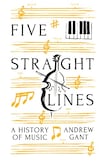
Five Straight Lines, as the subtitle says, is a history of music: not just of western music but of music per se. That’s 2½ global millennia in just over 600 pages, a moderately ambitious aim, not that there’s anything wrong with that.
Andrew Gant is based at St Peter’s College, Oxford University, where he teaches, composes and leads choirs. He sets out his stall immediately. This is a book about “the great works and the great lives”. As those unapologetic “greats” tell us, Gant’s is an old-fashioned view of music history. You don’t hear much talk of the great composers these days, what with all the baggage it has of the Romantic deification of the heroic artist.
We open with prehistory in brief before an overview of ancient Greek music. “The Greeks did it all first,” Gant remarks, telling us about Pythagoras and Aristoxenus, Greek instruments and modes, and the terms we’ve inherited (harmony and so on).
Here comes a problem: from this, the reader will be oblivious to the existence of, say, ancient Chinese music (which admittedly came a bit later) or ancient Babylonian musical notation (the oldest preserved notation in the world, from modern Asia). We never learn anything about Persian or Indian traditions. Europe is deemed all that’s worth talking about.
The book is certainly good on the western classical canon. The chapters on renaissance, baroque, classical and romantic periods give useful historical overviews for those who’d like to get into western classical.
For the Baroque period, we get a fine sense of how internationally diverse it was, and what it meant to be employed as a music-maker, from royal patronage to publishing agreements to the academies (de facto music social clubs, “dedicated to study and intellectual pursuit”). This will help you better understand the context for the oratorios, cantatas and chamber works heard in concert today.
“The best way to use this guidebook through the myriad mysteries of music,” Gant writes, “is to have a good sound system and streaming service to hand (or, even better, a ticket for a concert or a gig)”. Readers will find out about exquisite works such as Tallis’s 40-part choral Spem in Alium, Chopin’s piano Preludes, and Verdi and Wagner’s operas; sometimes reading, in close succession, of Monteverdi, Corelli, Scarlatti, Lully, Bach and Handel and dozens of others works well. You can spend quite some time poring over the pages, listening to the many works.
At other times the information density left me unsatisfied. A sketch of Josquin as a charismatic composer of the Middle Ages no sooner comes to life than it’s abruptly ended, since we have to move onto something else.
Women composers feature in a token way (a combined two pages for Clara Schumann and Fanny Mendelsohn), with no discussion of why women were kept out of composing. There could and should be more on women such as Élisabeth Jacquet de La Guerre (not featured here) who, despite the odds, became significant in their day before being subsequently erased from the canon.
On the whole, I feel Five Straight Lines might have worked better if it had privileged representative examples from each age rather than trying to cover everything. There is one sentence on Wendy Carlos and one brief paragraph on Ravi Shankar and Asian music. Helmut Lachenmann, arguably the most influential European composer since 1970, gets a sentence or two. Such brevity often means a lack of insight and a box-ticking feel. One sentence on this composer and one sentence on that composer eventually comes to feel redundant.
When Gant turns his attention to pop music, the avalanche of factoids and titbits have no critical framing in terms of the commercial music industry, slavery and segregation, or information technology and mass media. Problematically, we’re told that “soul music was about raw emotion and, specifically, sex”. Anyone with a passing interest in African-American music knows that Curtis Mayfield and Marvin Gaye voiced urban social realism in the post-Jim Crow era. When Gant subsequently mentions how MTV helped black music, he seems not to know that MTV was exclusively white until its hand was forced by the success of Michael Jackson’s Billie Jean.
“Our Bach is a twenty-first century Bach,” Gant correctly notes in his conclusion, “very different from his ancestor the nineteenth-century Bach”. History is dynamic rather than static. I wonder whether he might have realised the same point about how histories can be written, since methodologically Five Straight Lines feels out of date.
To use an analogy: the TV series The Wire is ostensibly about drug crime in Baltimore. But really the writers use that example as a way into an analysis of the American empire in its decline. A different approach might have served Gant better: selective rather than comprehensive, going in-depth on particular actors to reveal the broader landscape of music history. And adding “western” to the title.








